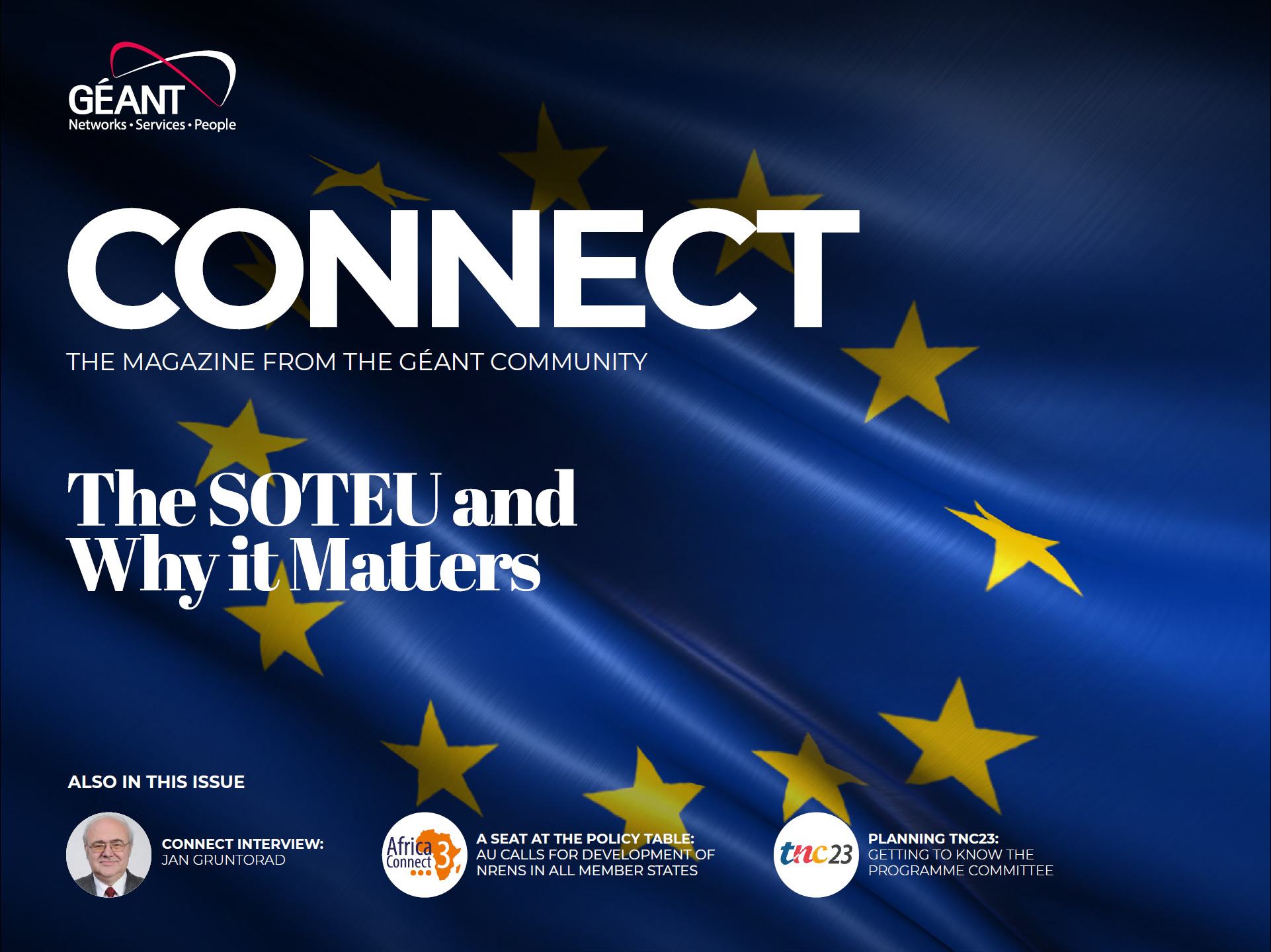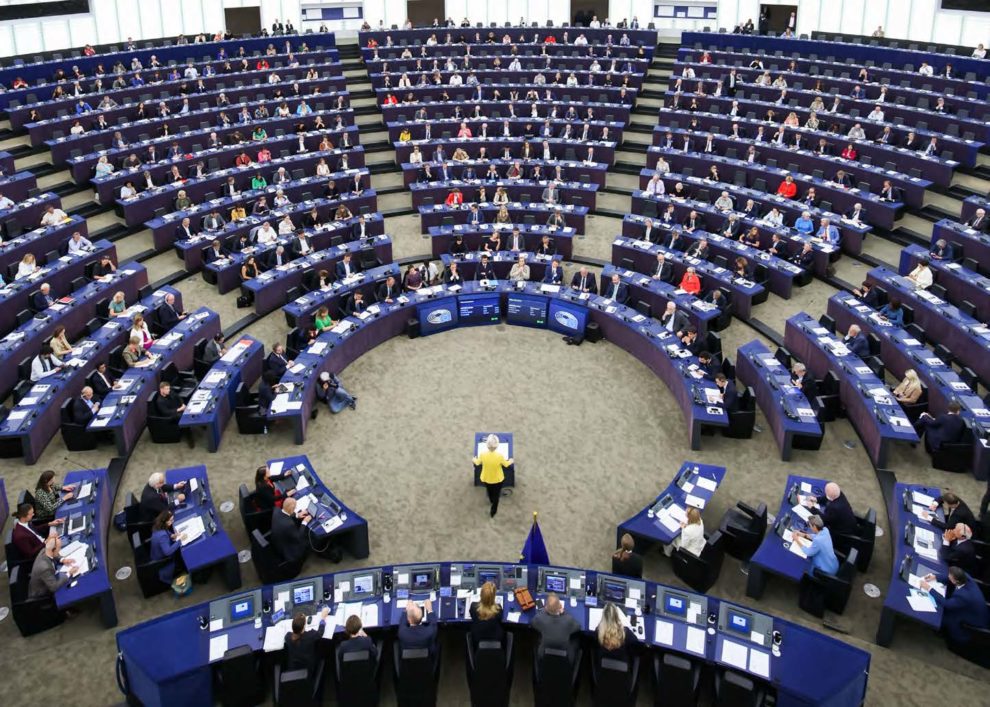Words: Hendrik Ike, Public Affairs Officer, GÉANT
On 14 September 2022, European Commission (EC) President Ursula von der Leyen delivered the annual State of the European Union address, or SOTEU. It was arguably one of the most important speeches delivered this year for European citizens, businesses, organisations, and Member States, due to an increasingly hostile geo-political environment and major economic challenges. It also delivered not just key messages for GÉANT and National Research and Education Networks (NRENs) to consume and understand but also highlighted the growing relevancy and salience of our community within Europe.
From the outset, the speech was governed by three overriding themes: the Ukrainian conflict, the global energy crisis, and safeguarding democracy, with a particular focus on their impact and effect on today’s generation of children and youth. Combined with a package of legislative interventions released on 18 October, the EC is aiming to protect and develop the continent in several ways. This is not the first time that von der Leyen has had to deal with crisis, and whilst she has already reached the third year of her premiership, legislative interventions are only on the increase. But why do these interventions matter to our community?
A Europe fit for the Digital Age – definitions and demarcations
In her original Political Guidelines, von der Leyen stressed the need for Europe to lead the transition to a healthy planet and a new digital world. Since then, many files have been set in motion and are close to finalisation – the Data Act, Secure Connectivity, EU Digital Identity, NIS2, CER, and the Digital Decade initiative, as examples. The brisk implementation of these initiatives will be the primary task of the Commission.
However, new proposals are forthcoming that were matched and published alongside the SOTEU address. These include the Cyber Resilience Act, an Artificial Intelligence Liability Directive, and a proposal for an EU cyber defence policy. There are also plans for an upcoming Connectivity Infrastructure Act.
The EC’s attempts to shore up and secure its ongoing digital initiatives are increasing in speed due to global volatility. A part of this means securing current European assets, including digital ones. The aforementioned legislation will bring in rules and standards for organisations to increase their level of digital security, and GÉANT and the NRENs will be included within that fold. To what extent, is being closely monitored by the EU Liaison team at GÉANT.
Although already in motion, external-facing initiatives will also be prioritised in the name of digital sovereignty. The Global Gateway, the EC’s trade strategy to form hubs at the corners of Europe where trusted connections are to be made with partner countries, will be hugely important in this area. In the digital sector, the original aim was to help partner countries address the digital divide and help further integrate them into the global digital ecosystem. But between the lines, it is clear to see that this is a strategy designed to form a secure number of inter-regional doorways that will augment European data security and access methods. As such, there is the desire from the Commission to begin the demarcation of Europe’s digital boundaries to protect the Digital Single Market, and it is inevitable that this will affect GÉANT and the NRENs over the coming years, when the concern of research and education comes into play – be that from a security services perspective or when looking at future connectivity projects.
The Digital Single Market – a ‘Schengen for data’
The SOTEU address also firmly recognised the economic hardship enveloping the continent. Numerous plans were announced to help citizens and business cope with the rising cost of living crisis, which aim to bolster the already active Recovery and Resilience Facility that came into force last year, a key funding feature that was originally designed to finance reforms and investments in Member States during and following the COVID-19 pandemic. But more importantly, the Commission stated that considering recent events, it would review the way it coordinates and distributes funding. An example of this is a potential mid-term revision of the Multi-annual Financial Framework (MFF) – the key seven-year funding mechanism by which all European Union money is spent. There is also going to be an Economic Governance review that will impact the Stability and Growth Pact with more simplified rules and possibly increase the debt ceiling.
Also introduced is a European Sovereignty Fund and increased contributions to Important Projects of Common European Interest (IPCEI) such as batteries, hydrogen, semiconductors and their raw materials, and solar energy. The fund would complement the MFF (i.e. be outside of it) and is planned to be financed by common debt.
So, the Commission has economic plans, and digitisation is a key element of them. As the single market has been realised, so now is the beginning of the realisation of the Digital Single Market. A conceptual ‘Schengen for data’, the Commission is looking to pool both public and private data within Europe more effectively. As data is being viewed as less of an output and more of a resource with value, the Commission is looking to enhance the hybrid data created in Europe in order to stimulate the European economy at large. It hopes that this vision will be enabled via the creation of the Common European Data Spaces – or CEDS – that are thematically grouped in different 10 areas: the Green Deal, Health, Energy, Manufacturing, etc. The European Open Science Cloud (EOSC) is also classed as one of these spaces. Questions on how these spaces will be implemented, and to what extent our community is or will be involved, are growing.
As the sands of European digital and economic policy shift, so are the conversations being held across GÉANT and NRENs on such matters. Where do our connectivity and services sit? How do these policies translate nationally? Is the digital single market an opportunity for our R&E community, or a threat? Unfortunately, the answer is normally both, and things remain far from clear. What is clear, however, is the need to carefully monitor how these policies develop.
Protecting Democracy and the Role of Our Institutions
Ursula von der Leyen has made it clear that the institutions and governments that protect the European way of life are vulnerable. This is particularly relevant for GÉANT and NREN end-users – for example, research centres and universities have never faced so much pressure in remaining independent to the interests of third parties. In the boldly titled Defence of Democracy package, there are measures designed to protect European institutions, and that will include universities and research centres. Some existing legislation complements and arguably already falls under the package. The Digital Services Act is one, a regulation that, among other things, aims to ensure that online intermediaries and online platforms in particular are covered by one set of horizontal rules across the EU. The DSA includes rules on content moderation, as well as specific obligations for the transparency and accountability of the advertising systems of online platforms.
Clearly, NRENs and the services they provide to end-users can be affected by this. As per usual, it is the unknown that brings about guesswork and speculation. Von der Leyen also called for a new European Convention during her speech. Treaty change is serious, and especially so when it deals with the rights of European citizens. She understands that the balance between our real and digital lives is shifting and is therefore looking to safeguard planned European Digital Rights and Principles. How NRENs and GÉANT play a role in protecting these from an R&E perspective will need to be understood and illustrated in order to complement the Commission’s efforts in this area in the future. This is also in line with the European Research Area’s actions on academic freedom and numerous indicators and targets that fall under the United Nations’ Sustainable Development Goals.
Conducting such measures are also a useful exercise with regards to risk avoidance. To understand how our community will play its part in safeguarding the rights of researchers and educators also negates future reputational damage should our end-institutions face third party threats. And so the subject of security returns – the subject that coursed within Ursula von der Leyen’s address and throughout the European Parliament.
More Than a Feeling – a Matter of Perspective
Listening to or reading von der Leyen’s address will mean many different things to many different people. It will also mean different things to different Member States. As easy as it could be for one to become emotional over the subjects she raised during the speech, it was clear throughout that the work of our community is very much aligned with the greater good that von der Leyen described. Thematically, the areas covered highlighted how invaluable NRENs and RENs are. Whether it is the urgent need to find new energy solutions, researching the impact of climate change on our planet, or investing in education for the next generation (another strong aspect of her speech), it was at moments hard to imagine how many of the Commission’s ambitions could be met without the infrastructure provided by our community for end-users.
As such, this was therefore a speech that not only highlighted what initiatives will impact NRENs and GÉANT, but also re-affirmed how valuable the community is – if you are aware of it. Hence, the speech also brought about a question of perspective. A policymaker in the Commission who is aware of the GÉANT/NREN ecosystem will be at ease in knowing how and where our infrastructure aids their vision. If they’re not, they’re not, and that can be harmful when we see planned future work programmes or projects that have the potential to duplicate the community’s work for little extra benefit. It is therefore in our joint interest that NRENs and GÉANT invest an appropriate amount of effort when attempting to understand future requirements, initiatives and projects, and relay feedback and concerns back to policy makers, both at the national and European level. This is already seen at different levels of our ecosystem and is directed at different actors or ideas. Be the focus on EOSC, EuroHPC, Quantum, International Connectivity, or our own GN5 project, all tiers of interaction are necessary, and so engagement is needed on policy, with partners, and with engineers and scientists on the ground. This ‘upstream’ – ‘midstream’ – ‘downstream’ approach can help ensure the sustainability of GÉANT and the NRENs for decades to come.
To End on the Future
It could be easy to interpret von der Leyen’s speech as reactive – or misconstrue it as a holding action for what is a very complicated regional crisis. Yet it also demonstrated that the need for NRENs and GÉANT has never been greater. To ensure continued success, a combination of hard work, reciprocal trust, and community spirit will be needed from both within our ecosystem and when working with external partners and policy makers. Should that be the case, and that GÉANT and the NRENs voice their importance to key constituents and stakeholders, then our future has been plainly laid out by Ursula von der Leyen to our community – it can be as promising as we wish it to be.

Read or download the full magazine here







